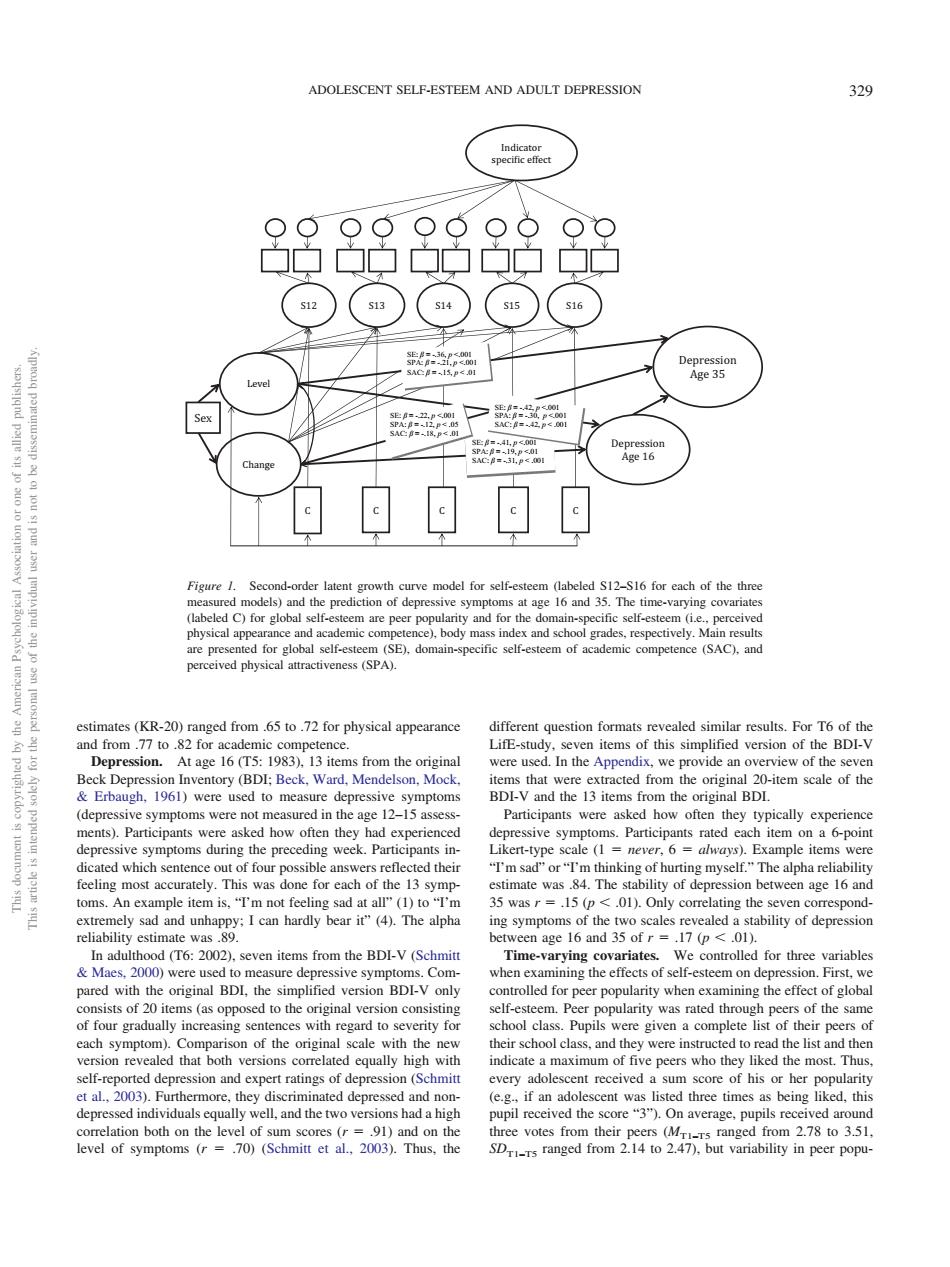正在加载图片...

ADOLESCENT SELF-ESTEEM AND ADULT DEPRESSION 329 O6o6O6O▣O 白中白中白中白中中中 Ase 16 odel for self-esteem dabeled $12-$16 for each of the thr (SE).domain-s d physical attractiveness (SPA) estion form BDI-V and the 1 from lepres aaimeebR n ex 5 was r .15 (p <.01).Only correl alpha 7p<01 ared ith the,the BDI-o ontrolled for peer popularity when examining the effect of global elf-r orted depression and expert ratines of depress e.g. times as being lik d,th lation both on the level of sum scores .91)and on the anged 0m278o35 level of symptoms( .70)(Schmitt et al..2003).Thus,the estimates (KR-20) ranged from .65 to .72 for physical appearance and from .77 to .82 for academic competence. Depression. At age 16 (T5: 1983), 13 items from the original Beck Depression Inventory (BDI; Beck, Ward, Mendelson, Mock, & Erbaugh, 1961) were used to measure depressive symptoms (depressive symptoms were not measured in the age 12–15 assessments). Participants were asked how often they had experienced depressive symptoms during the preceding week. Participants indicated which sentence out of four possible answers reflected their feeling most accurately. This was done for each of the 13 symptoms. An example item is, “I’m not feeling sad at all” (1) to “I’m extremely sad and unhappy; I can hardly bear it” (4). The alpha reliability estimate was .89. In adulthood (T6: 2002), seven items from the BDI-V (Schmitt & Maes, 2000) were used to measure depressive symptoms. Compared with the original BDI, the simplified version BDI-V only consists of 20 items (as opposed to the original version consisting of four gradually increasing sentences with regard to severity for each symptom). Comparison of the original scale with the new version revealed that both versions correlated equally high with self-reported depression and expert ratings of depression (Schmitt et al., 2003). Furthermore, they discriminated depressed and nondepressed individuals equally well, and the two versions had a high correlation both on the level of sum scores (r .91) and on the level of symptoms (r .70) (Schmitt et al., 2003). Thus, the different question formats revealed similar results. For T6 of the LifE-study, seven items of this simplified version of the BDI-V were used. In the Appendix, we provide an overview of the seven items that were extracted from the original 20-item scale of the BDI-V and the 13 items from the original BDI. Participants were asked how often they typically experience depressive symptoms. Participants rated each item on a 6-point Likert-type scale (1 never, 6 always). Example items were “I’m sad” or “I’m thinking of hurting myself.” The alpha reliability estimate was .84. The stability of depression between age 16 and 35 was r .15 (p .01). Only correlating the seven corresponding symptoms of the two scales revealed a stability of depression between age 16 and 35 of r .17 (p .01). Time-varying covariates. We controlled for three variables when examining the effects of self-esteem on depression. First, we controlled for peer popularity when examining the effect of global self-esteem. Peer popularity was rated through peers of the same school class. Pupils were given a complete list of their peers of their school class, and they were instructed to read the list and then indicate a maximum of five peers who they liked the most. Thus, every adolescent received a sum score of his or her popularity (e.g., if an adolescent was listed three times as being liked, this pupil received the score “3”). On average, pupils received around three votes from their peers (MT1–T5 ranged from 2.78 to 3.51, SDT1–T5 ranged from 2.14 to 2.47), but variability in peer popuSE: β = -.41, p <.001 SPA: β = -.19, p <.01 SAC: β = -.31, p < .001 Level Change Depression Age 35 Sex S12 S13 S14 S15 S16 Indicator speciic effect Depression Age 16 C C C C C SE: β = -.36, p <.001 SPA: β = -.21, p <.001 SAC: β = -.15, p < .01 SE: β = -.22, p <.001 SPA: β = -.12, p < .05 SAC: β = -.18, p < .01 SE: β = -.42, p <.001 SPA: β = -.30, p <.001 SAC: β = -.42, p < .001 Figure 1. Second-order latent growth curve model for self-esteem (labeled S12–S16 for each of the three measured models) and the prediction of depressive symptoms at age 16 and 35. The time-varying covariates (labeled C) for global self-esteem are peer popularity and for the domain-specific self-esteem (i.e., perceived physical appearance and academic competence), body mass index and school grades, respectively. Main results are presented for global self-esteem (SE), domain-specific self-esteem of academic competence (SAC), and perceived physical attractiveness (SPA). This document is copyrighted by the American Psychological Association or one of its allied publishers. This article is intended solely for the personal use of the individual user and is not to be disseminated broadly. ADOLESCENT SELF-ESTEEM AND ADULT DEPRESSION 329��